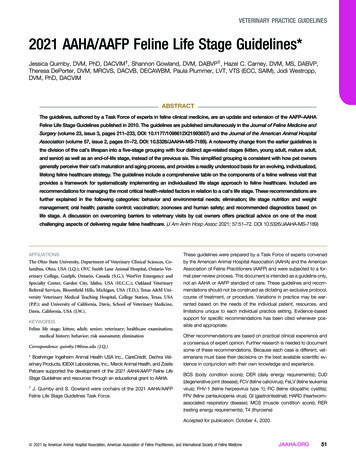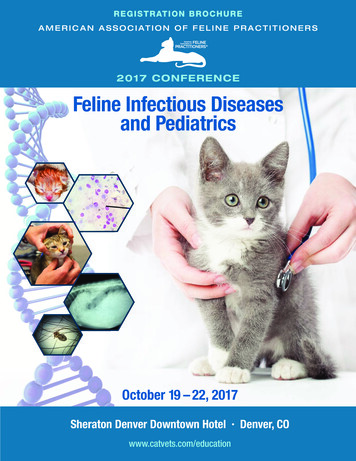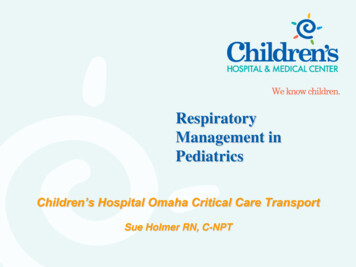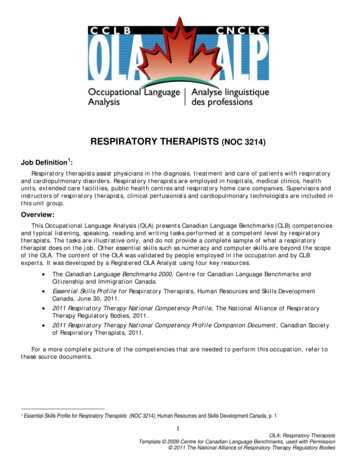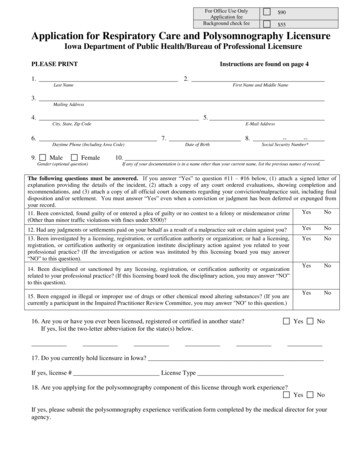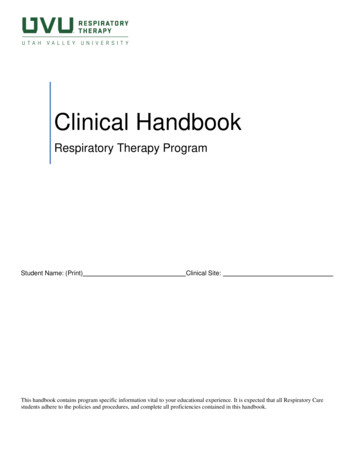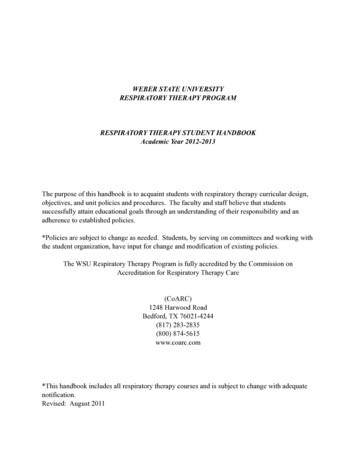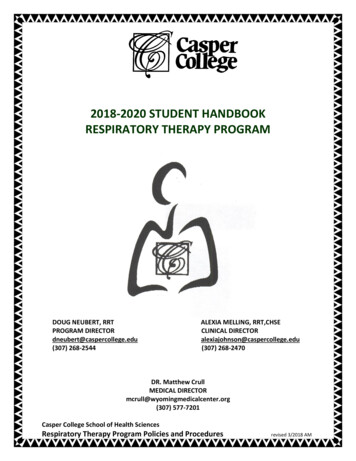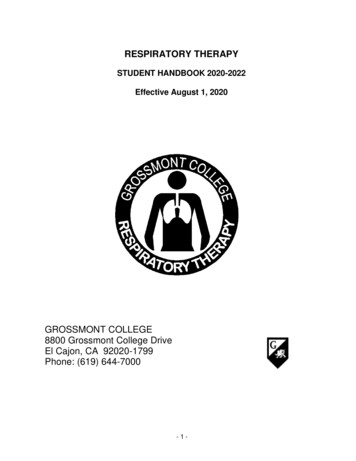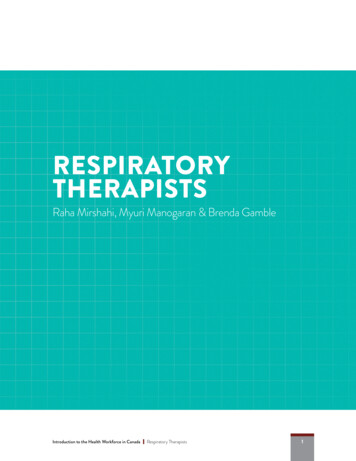
Transcription
Pleural Effusion in CatsFeline Respiratory DiseaseLower Respiratory Tract DiseaseMartha CannonBA VetMB DSAM(fel) MRCVSRCVS Specialist in Feline Medicinewww.vet-eCPD.comwww.centralcpd.co.ukMartha Cannon, BA VetMB DSAM(Fel) RCVS Specialist in Feline Medicine,Oxford Cat Clinic01865 243000enquiries@oxfordcatclinic.co.ukSept 2014
Pleural Effusion in CatsFeline Chronic Bronchial DiseaseChronic inflammation of the lower airways (chronic bronchial disease) is a common cause of coughing,wheezing and acute expiratory dyspnoea in cats. Affected cats have inflammation of the bronchialmucosa, increased bronchial mucus production and narrowing of the lower airways. Clinical signs may beintermittent or persistent and most cases respond well to corticosteroids.Chronic Bronchitis vs Feline AsthmaStudies of the cytological content of bronchoalveolar lavage (BAL) samples from affected cats havesuggested that there are two distinct sub-groups and this has lead to a suggestion that there may be atleast two different disease processes that may produce the same clinical characteristics: Chronic Bronchitis: the majority of cases have a predominantly neutrophilic bronchoalveolarinflammation, although bacterial involvement appears to be rare.Feline bronchial asthma: proposed to be an allergic airway reaction to inhaled allergens andcharacterised by a primarily eosinophilic or mixed inflammatory cell content of the bronchialmucus.In humans asthma appears to be a type 1 hypersensitivity reaction to inhaled allergens, and it ischaracterised by reversible airway narrowing due to airway hyper-reactivity; increased mucus productionand smooth muscle hypertrophy secondary to lower airway inflammation. The majority of cats withchronic lower airway do not meet these criteria, but they are found in a small proportion of cats withnaturally occurring chronic bronchial disease and can also be induced experimentally to produce a felinemodel of allergic asthma.At present there are no widely accepted, standardised criteria that can be used to distinguish chronicbronchitis from feline asthma and consequently confusion exists in the literature as to how to define thetwo conditions, or indeed whether it is appropriate to attempt to do so.Clinical PresentationChronic bronchial disease (CBD) can occur at any age but is most commonly seen in young to middleaged adult cats. It affects cats of all breeds but Siamese and Oriental cats appear to be over-represented.Clinical signs include chronic cough, lethargy, exercise intolerance, exercise induced open mouthbreathing, audible expiratory wheeze, tachypnoea, dyspnoea, and acute respiratory distress. These signsmay be acute or chronic and non-progressive. The cough is typically harsh and associated with activeabdominal effort, often leading owners to report that the cat has a fur ball, or a foreign body stuck in thethroat. Coughing can be intermittent or may be relatively constant and may be exacerbated by airwayirritants such as cigarette smoke, house dust or pollen.Some affected cats develop acute bronchoconstriction causing severe respiratory distress, tachypnoea,cyanosis or collapse, not always associated with a previous history of cough or laboured respiration.Physical ExaminationMost affected cats present with tachypnoea, with or without a prolonged expiratory phase or an expiratory/ abdominal push. The presence of increased expiratory effort is an indication of lower airwaynarrowing or obstruction. Cats with chronic airway disease may display a barrel-chested appearance anddecreased thoracic compressibility because of over-inflation and emphysema.Cough is a common feature of feline bronchial disease, and detection of a cough in the cat that presentswith respiratory distress or tachypnoea is a major clue to the presence of underlying inflammatory airwaydisease. Affected cats show variable degrees of tracheal sensitivity following palpation and increasedtracheal noise on tracheal auscultation.Thoracic auscultation reveals harsh lung sounds, inspiratory crackles, or expiratory wheezes in around66% of cats; however, the absence of such sounds does not rule out inflammatory airway disease.Emergency TreatmentMartha Cannon, BA VetMB DSAM(Fel) RCVS Specialist in Feline Medicine,Oxford Cat Clinic01865 243000enquiries@oxfordcatclinic.co.ukSept 2014
Pleural Effusion in CatsDiagnostic tests should be kept to a minimum initially in cats presenting with signs of acutebronchoconstriction such as cyanosis, tachypnoea, and open-mouth or abdominal breathing. Stabilisationcan be achieved by providing an oxygen-enriched environment and using parenteral administration of aβ2 agonist such as terbutaline. This is an effective bronchodilator in cats with airway disease that havereversible airway constriction. It is a relatively safe drug with few cardiac side effects and can beadministered subcutaneously, intramuscularly or intravenously at 0.015 mg/kg. It is rapid in onset, and anadditional dose can be administered after 30 minutes if required.Butorphanol (0.3 – 0.5 mg/kg i/m or s/c) will reduce anxiety without lowering blood pressure or affectingcardiovascular function and may allow the cat to cope better with handling for emergency treatment.Respiratory rate and effort should then be monitored visually in the first hour of observation to determinea therapeutic response. If the cat does not respond to terbutaline, use of a short-acting corticosteroid(dexamethasone: 0.25 – 0.5 mg/kg i/m or i/v; inhaled fluticasone) often results in rapid alleviation ofclinical signs caused by inflammatory airway disease. While systemic use of corticosteroid affects furtherdiagnostic testing it may be required to stabilise the cat.If the cat fails to respond to these measures, causes for respiratory distress other than chronic bronchialdisease should be investigated. Pulmonary oedema is the most likely remaining differential diagnosis inthe cat presenting with acute cough and dyspnoea and it differentiating chronic bronchial disease fromcardiogenic pulmonary oedema can be challenging in the emergency situation. Trial treatment withfrusemide may be appropriate. An in house SNAP test will soon be available to assess feline pro-BNP.While the test has significant limitations as a screening test in healthy cats, it should prove useful indistinguishing most cats with congestive heart failure from those with non-cardiac disease, especiallywhen used in conjunction with other physical, ultrasound and radiographic findingsFurther InvestigationsChronic bronchial disease is the most common cause of chronic or intermittent coughing in cats. Otherdifferential diagnoses include: Parasitic infections:oRound worms can cause transient coughing due to visceral larva migrans – more common inkittens than in adult cats.oLungworm - Aelurostrongylus abstrusus, present in some geographic regions of the UK.Most infections are self-limiting and sub-clinical, but can cause coughing and in rare casessevere respiratory distress and pneumothorax or pyothorax. Clinical disease is more likely inkittens or immunosuppressed adult cats. If infection is documented or suspected as a causefor airway inflammation treatment is with fenbendazole (50mg/kg p/o q 24 hrs for 3 days), orsingle applications of imidaclopric/moxidectin (Advocate), or emodepside/praziquantel(Profender – effective against Aelurostrongylus abstrusus, but not against Eucoleusaerophilus).oHeartworm – Dirofilaria immitis, rare in cats and not present in the UK, but may be ofconcern in cats imported from elsewhereFur balls – owners will frequently describe the action of attempting to clear a fur ball as a “cough”Bronchopneumonia – see laterPulmonary oedema – see laterPulmonary neoplasia – see laterThoracic RadiographyWell positioned, inflated thoracic radiographs are an important part of the investigation of the coughingcat. To get good diagnostic films will usually require sedation or anaesthesia and the latter may bepreferred as it ensures control of the airway and allows the lungs to be gently inflated, providing the mostdiagnostic information from the films.Radiographic findings are highly variable: the classic indicators of lower airway disease are: Lung hyperinflation, leading to flattening of the diaphragm and increased space between thecaudal edge of the cardiac shadow and the diaphragmPeribronchial infiltrates – appearing as “doughnuts” or “tram-lines”. Changes may be severe andgeneralised, but may be subtle or even absent.Martha Cannon, BA VetMB DSAM(Fel) RCVS Specialist in Feline Medicine,Oxford Cat Clinic01865 243000enquiries@oxfordcatclinic.co.ukSept 2014
Pleural Effusion in Cats Lobar collapse – usually involving the right middle lung lobeSome cats develop a mild interstitial pattern, or focal alveolar infiltrates due to mucous pluggingof large airways causing secondary atelectasis.Radiographic changes are therefore highly variable; they may be non-specific, subtle or even absent insome cases. Thoracic radiographs are nevertheless important for ruling out other causes of cough.BronchoscopyIf bronchoscopy is available it can be a useful adjunct to other diagnostic investigations.A small endoscope (preferably 2.5 to 3.8 mm outer diameter) is required – the smaller the insertion tubethe easier it is to manipulate within the airways of cats. The cat is anaesthetised with intravenous agents(e.g.alfaxan, propofol) and oxygen supplementation is supplied through an oxygen cannula (e.g. a cutdown canine urethral catheter) passed down the trachea. The endoscope is passed into the trachea andall large airways are examined.Abnormalities that may be seen include hyperaemia, oedema, mucus accumulation and reduction inairway diameter.NB: Bronchoscopy can induce severe bronchospasm in cats with chronic airway disease. Pre-treatmentwith a bronchodilator such as terbutaline may reduce this risk (0.015 mg/kg i/m or s/c given 2 to 4 hoursprior to induction of anaesthesia). Should bronchospasm occur manual ventilation will be required untilthe bronchospasm relaxes and atropine may help to relieve the smooth muscle constriction.Bronchoalveolar LavageCollection of airway samples for cytology and bacterial culture is an important part of the investigation oflower airway disease in the cat. Collection of good samples can be achieved safely and inexpensivelywithout the aid of a bronchoscope: Pre-treat the cat with terbutaline- 0.015 mg/kg i/m or s/c, 2 to 4 hours prior GAAnaesthetise the cat and use an uncuffed ET tube and inhalation anaesthetic to induce stableanaesthesia, and to allow thoracic radiography and any other investigations that may be required.Position the cat in lateral recumbency then re-intubate with a sterile, uncuffed ET tube of thewidest diameter that can comfortably be passed into the tracheaEnsure i/v access is maintained, and use aliquots of alfaxan or propofol to maintain an adequateplane of anaesthesia.Pass a sterile 6 or 8 French catheter through the ET tube and advance the catheter until it lodgeswithin the distal airway. Infuse 5 – 10 mls of warmed sterile saline then immediately re-aspirateas much fluid as possible back into the catheter and syringe.oCoupage of the chest during the lavage procedure may improve the yield of mucus retrievedoTypically approx 40-50% of the volume instilled is retrieved, much of which will remain in thecatheter – maintain negative pressure on the catheter as it is removed to prevent loss of thisportion of the sampleoThe presence of foam on the meniscus of the sample indicates the presence of surfactantand confirms an alveolar sampleRepeat the process with a fresh supply of saline.Administer 100% oxygen through the ET tube for 5-10 minutes following the procedure.Sample Handling:Depending on the volume of material retrieved: pool the samples and divide it between: A plain sterile collection tube to be submitted for bacterial cultureAn EDTA tube to submit for cytologyA plain eppendorf for in-house cytology:oCentrifuge immediately or place on ice for later analysisoAfter centrifugation make an air-dried smear from a sample of the pelletoStain with diff-quick or Wright’s stainoExamine under the microscope and count at least 200 cells per slide to determine thedifferential cell countCytologyMartha Cannon, BA VetMB DSAM(Fel) RCVS Specialist in Feline Medicine,Oxford Cat Clinic01865 243000enquiries@oxfordcatclinic.co.ukSept 2014
Pleural Effusion in CatsCats with idiopathic lower respiratory tract inflammation can have primarily neutrophilic or eosinophiliccytology. The significance of the primary cellular infiltrate currently is unknown, and it appears that morecats have primary neutrophilic inflammation than eosinophilic inflammation.BacteriologyCulture for aerobic bacteria and culture or PCR testing for Mycoplasma should be performed in cats withcough or tachypnoea but the results should be interpreted with care: Light growth of bacteria from the lower airways of cats with and without bronchial disease iscommon, occurring in approximately 75% of healthy or bronchitic cats. True infection typically isassociated with systemic signs of illness, degenerative or septic airway cytology, and a positiveresponse to antimicrobial therapy.The role of Mycoplasma spp infection in respiratory disease is controversial. It has been isolatedfrom cats with various types of lower respiratory disease, but not from healthy cats. Mycoplasmainfection may worsen airway hyper-reactivity even if it is not a primary cause of lower airwaydisease.TreatmentSituations that might provoke bronchoconstriction should be avoided, particularly in cats that developacute attacks of severe respiratory distress. Cigarette smoke, dusty cat litters, aerosol sprays, pollutedenvironments, stressful situations, and upper respiratory virus infection (e.g. herpes virus, calicivirus) cantrigger clinical signs in susceptible cats.Current treatment involves a combination of anti-inflammatory agents and broncho-dilators.Approximately one half to two thirds of cats require lifelong medication.Corticosteroids are effective in emergency therapy and in chronic management of this disease. Theyreduce inflammation by controlling inflammatory mediators and by decreasing migration of inflammatorycells into the airway. The duration and dose of corticosteroid therapy depends on the degree andchronicity of clinical signs, the severity of the pulmonary infiltrate, and the severity of inflammation oncytology.For long term treatment several routes of administration are possible, the choice will depend on theseverity of the disease and the compliance of the owner and the cat: Prednisolone 1 mg/kg PO twice daily for 5 to 10 days, then if a good response is achievedgradually taper the dose to the minimum effective dose over a period of 2 – 3 months.oRecurrent episodes of coughing or respiratory distress requires a return to the original dose.oMonitoring is required for common side effects such as weight gain and diabetes mellitus Inhaled fluticasone proprionate (Flixotide) via face mask and spacer chamber (e.g. Aerokat). 110250 µg twice dailyoIt can take a little time to acclimatise a cat to the regular use of a face mask. In the interimstandard doses of oral steroids can be used for the first few weeks, tapering downward onceeffective inhaled therapy is underway.oSide effects noted in human medicine include adrenal suppression with long-term and highdose use, thinning of the skin, perioral dermatitis and oral infection (particularly withcandidiasis). These complications appear to be rare in veterinary patients.oInhaled medications are significantly more expensive than oral or injectable alternatives andthis may prove to be prohibitive for some owners especially for cats on life-long treatment Depot injections of methylprednisolone acetate (10 to 20 mg IM every 2 to 8 weeks) may beadequate in some cases and may be required in cats that are non-compliant with tablets orinhaled medication. However this is the least ideal route as it provides only sporadic control ofairway inflammation.Bronchodilators: Airway narrowing and smooth muscle hypertrophy can contribute significantly to theclinical signs or wheezing, increased respiratory effort, cough and lethargy. Bronchodilators reduceairway resistance and can be helpful in both the emergency treatment and the long term management ofchronic airway disease. Concurrent use of a bronchodilator may reduce the dose of corticosteroidrequired to control the clinical signs and in mild cases bronchodilators alone may control the signs.Martha Cannon, BA VetMB DSAM(Fel) RCVS Specialist in Feline Medicine,Oxford Cat Clinic01865 243000enquiries@oxfordcatclinic.co.ukSept 2014
Pleural Effusion in CatsHowever caution is required when using bronchodilators as sole therapy - in humans sudden deaths havebeen reported where bronchodilators have been used alone, increasing airway patency allowsinflammatory mucus to be inhaled deeper into the bronchial tree causing obstruction of lower airways.Concurrent use of anti-inflammatory agents should reduce this risk.Terbutaline (Bricanyl) can be administered orally at a dose of 0.1-0.2 mg/kg twice dailyoGenerally very well tolerated, but potential adverse effects include tachycardia, CNSstimulation, tremors and hypokalaemia.oUse with caution in cats with heart disease, hyperthyroidism, hypertension, diabetes orseizure disorders. Theophylline (Corvental-D) 6-8 mg/kg p/o twice daily.oPotential adverse effects include tachdysrhythmias, increased gastric acid secretion andCNS stimulation. Increased risk of toxicity if administered with cimetidine or enrofloxacin andincreased risk of seizures when administered with ketamine. Salbutamol/Albuterol (Ventolin) can be administered via the inhaled route, dose 90 µg whenneeded. Useful as an emergency treatment during an acute episode, or for long term control ofmild cases with intermittent signs (clinical signs occurring up to twice a week) where onlyintermittent use is required.oChronic daily use of salbutamol has been associated with increased severity of airwayinflammation in feline experimental models.oIf using both inhaled bronchodilators and corticosteroids, administer the bronchodilator first,followed by the corticosteroid 5 – 10 minutes later. .Antibiotics should be prescribed based on culture and sensitivity and cytology results because airwayinfection may contribute to bronchial inflammation and hyper-responsiveness. If infection withMycoplasma spp is documented a clinical trial of doxycycline (5 to 10 mg/kg PO q12 – 24 hrs) can beused.Other Treatment OptionsAlternative anti-inflammatory drugs may be beneficial in some cats: Cyproheptadine (Periactin, 2 mg per cat, once or twice daily). In an experimental model of felineasthma, cyproheptadine, a serotonin-receptor blocker, attenuated airway constriction of isolatedbronchial strips in vitro. Serotonin levels have not been measured in naturally occurring felinebronchial disease but some cats appear to benefit from cyproheptadine.Cyclosporine (Atopica; Novartis): an inhibitor of T lymphocyte activation, attenuatesbronchoconstriction and airway remodelling in asthmatic human patients and in a feline model ofairway hyperreactivity. Other agents are more suitable for first-line therapy of feline bronchialdisease; but cyclosporine could be considered for cases that are nonresponsive to standardtherapy.Drugs to Avoid:Feline airways are rich in sympathetic innervation, and β2-adrenergic activation is important in providingbronchodilation. Therefore β-blockers such as propanolol (a nonspecific beta blocker) and atenolol(primarily a β1-blocker) should be avoided if bronchial disease is suspected.Atropine is a potent bronchodilator and can be used in the management of acute bronchospasm butshould not be used chronically because it thickens bronchial secretions and encourages mucous pluggingof airways.Chronic daily use of inhaled salbutamol has been associated with increased severity of airwayinflammation in feline experimental models.Martha Cannon, BA VetMB DSAM(Fel) RCVS Specialist in Feline Medicine,Oxford Cat Clinic01865 243000enquiries@oxfordcatclinic.co.ukSept 2014
Pleural Effusion in CatsOther Causes of Chronic CoughChronic bronchial disease / asthma is the most common cause of chronic coughing in cats. Otherpotential causes include:Pulmonary oedema: most affected cats suffer tachypnoea and dyspnoea but not cough, howeversome individuals will present with a cough, which is frusemide responsiveoIn cats pulmonary oedema is often patchy and diffuse with highly variable radiographicappearanceoCardiogenic pulmonary oedema is the most common cause, but other causes such as recentseizure activity, electric shock, anaphylaxis etc are possible Bronchopneumonia: Acute inflammatory exudate initially fills alveolar spaces radiating from thebronchioles causing areas of consolidation oriented around terminal bronchioles, In cats, it mostcommonly occurs in cranioventral lung lobes.oMost commonly bacterial (e.g Mycobacterium spp), mycoplasma or aspiration in origin.oTreatment includes broad-spectrum antimicrobials such as amoxicillin/clavulanate orclindamycin and supportive therapy. Pulmonary neoplasia: most cats with pulmonary neoplasia, whether primary or metastatic, showfew if any clinical signs until disease is advanced. Coughing is more likely if the site and size ofthe mass causes physical obstruction to the trachea or major bronchi. Idiopathic Pulmonary Fibrosis: A chronic disease that frequently presents with an apparent acuteonset. Most common in middle-aged and older cats.oCauses severe multifocal interstitial fibrosis with foci of fibroblast/myofibroblasts, alveolarepithelial metaplasia, interstitial smooth muscle metaplasia/hyperplasia, but no inflammatoryresponse.oProduces an inspiratory dyspnoea, or a mixed inspiratory and expiratory dyspnoea.oThere are no consistent hematologic or biochemical abnormalities, and radiographicchanges are highly variable, but predominantly interstitial.oBronchoalveolar lavage,and/or fine needle aspirate are acellular because there is nosignificant inflammatory component. They may help rule out other causes of lung disease butit should be noted that cats with idiopathic pulmonary fibrosis may not tolerate BAL and insome cases it can precipitate acute and fatal decompensation.oConfirmation of diagnosis requires histopathology (usually at post-mortem).oThere is no effective treatment: corticosteroids and bronchodilators are often used but withdoubtful effect.oAverage reported survival time is 5-6 months. Martha Cannon, BA VetMB DSAM(Fel) RCVS Specialist in Feline Medicine,Oxford Cat Clinic01865 243000enquiries@oxfordcatclinic.co.ukSept 2014
Pleural Effusion in CatsPleural Effusion in CatsPleural effusion is a common cause of severe dyspnoea in cats, which often presents as an emergencywith an apparently acute onset despite the effusion having built up over a period of days or even weeks tomonths.Acutely dyspnoeic cats must be handled with extreme care to avoid potentially fatal stress-induceddecompensation of the compromised cat.Minimal handling, cage rest, warmth and oxygen support are essential components of the initialinvestigation and treatment of any dyspnoeic cat.If the cat is significantly stressed by its environment and disease consider using butorphanol (0.3 – 0.5mg/kg i/m or s/c). This will reduce anxiety without lowering blood pressure or affecting cardiovascularfunction and may allow the cat to cope better with handling for emergency treatment.Identifying Pleural EffusionA good clinical history and physical examination should provide strong indicators as to whether adyspnoeic cat has pleural effusion and can be achieved with minimal handling/restraintClinical History: Most cats with pleural effusion will have chronic disease so there are likely tobe some indications of previous changes in the clinical history, even if the owner has not beensufficiently concerned to seek veterinary help.oSome causes of pleural fluid are genuinely acute in onset – e.g. haemothorax due to traumaor rodenticide poisoning Respiratory Pattern: Pleural space disease causes dyspnoea with increased inspiratory effort. Thoracic Auscultation: Muffled lung sounds ventrally, muffled heart soundsoMay be associated with heart murmur or gallop rhythm if cardiogenic Other physical findings: Ventral dullness on thoracic percussion, poor thoracic compressibilityon gentle compression of the cranial thorax. Further InvestigationsWhere the history and physical examination provide strong indications of pleural effusion proceed tothoracocentesis once the cat is stable – this will provide samples for essential further diagnosticinvestigations but will also relieve the immediate life-threatening respiratory compromise.If the history and physical examination findings are equivocal use diagnostic imaging to confirm thediagnosis, but procede with caution in the acutely dyspnoeic cat:NEVER restrain a dyspnoeic cat in lateral recumbency for radiography or ultrasonographyIf ultrasound is available, allow the cat to rest comfortably in sternal recumbency and provideoxygen. Do not clip the coat; apply surgical spirit and ultrasound gel to the lateral thoracic wall ator just below the level of the costo-chondral junctions and apply the ultrasound probe to establishwhether fluid is present. Do not attempt a full examination of the heart and thorax. If fluid ispresent, proceed to thoracocentesis. If ultrasound is not available consider whether it is safe to take a conscious dorso-ventral thoracicradiograph, Use minimal restraint. Do not aim for perfect positioning, take what you can get – itwill be adequate to identify pleural effusion if it is present in moderate to large volume.oSet up the x-ray generator and cassette, pre-set the required exposures and collimate thebeam. Position all required markers on the cassette.oGently encourage the cat to adopt a comfortable sternally recumbent position and GENTLYrestrain with sand bags if necessary and if tolerated.oConsider using a narrow upright cardboard box, open at one end and with a “viewing hole” inthe other end. Some cats will take the opportunity to crawl into the box for safety, and the Martha Cannon, BA VetMB DSAM(Fel) RCVS Specialist in Feline Medicine,Oxford Cat Clinic01865 243000enquiries@oxfordcatclinic.co.ukSept 2014
Pleural Effusion in Catsbox will maintain the cat in a roughly sternal position under the primary beam allowing a“rough and ready” radiograph to be taken.Martha Cannon, BA VetMB DSAM(Fel) RCVS Specialist in Feline Medicine,Oxford Cat Clinic01865 243000enquiries@oxfordcatclinic.co.ukSept 2014
Pleural Effusion in CatsCommon Causes of Pleural Effusion:In cats the most common causes of pleural effusion are: Congestive heart failureFeline Infectious Peritonitis (FIP)PyothoraxChylothorax – most commonly due to congestive heart failure, but can be secondary toneoplasia, or may be idiopathic.Intra-thoracic neoplasia: lymphoma, mesotheliomaLess common causes of pleural fluid / effusion include: Acute pancreatitis - may cause pleural and/or abdominal effusions as a consequence of therelease of systemic inflammatory mediators (Systemic Inflammatory Response Syndrome).Diaphragmatic hernia and secondary lung lobe torsionHaemothorax due to coagulopathy, trauma or a bleeding neoplasm.Severe hypoalbuminaemia, most commonly secondary to nephrotic syndromeInvestigation of Pleural Effusion:As listed above the differential diagnosis list for a cat presenting with severe dyspnoea due to pleuraleffusion is relatively short. The clinical history and physical examination will help to rank thesedifferentials and allow a logical approach to emergency treatment and stabilisation.Collection and analysis of a sample of effusion will then provide further information as well as relieving theimmediate respiratory compromise. Samples of fluid should be collected into EDTA, heparin and plaintubes to allow the full range of tests that might become relevant:Classification of Pleural Effusion in CatsTaken from: Beatty J and Barrs V. Pleural Effusion in the cat: A Practical Approach to Determining theAetiology. Journal of Feline Medicine and Surgery 2010; 12: edCellCount(x109/L)CommentsTransudate 25 heartfailure,fluidoverloadModifiedTransudate25- ‐35500- xudate 30 5,000Maybesub- ‐classifiedasseptic,non- fusionwithatriglyceridecontentof 1.12mmol/LMartha Cannon, BA VetMB DSAM(Fel) RCVS Specialist in Feline Medicine,Oxford Cat Clinic01865 243000enquiries@oxfordcatclinic.co.ukSept 2014
Martha Cannon, BA VetMB DSAM(Fel) RCVS Specialist in Feline Medicine, Oxford Cat Clinic 01865 243000 enquiries@oxfordcatclinic.co.uk Sept 2014 Feline Respiratory Disease . catheter - maintain negative pressure on the catheter as it is removed to prevent loss of this portion of the sample
